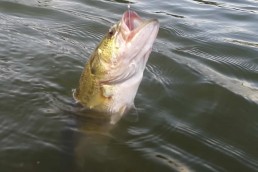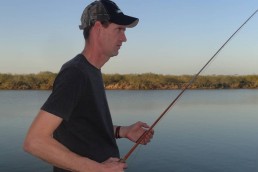Crankbaits Make Bass Fishing Even More Fun
SHARE THIS POST
Ever since the days of Dame Juliana and Izaak Walton, lure makers have attempted to duplicate the look, action and feel of the prey species upon which predators depend on for sustenance. Color, shape, length and wobble all have been refined to mimic the actions of real food. Whether or not a fish bites on a lure basically comes down to how it moves through the water. This is largely determined in crankbaits by the bill on the front of the lure, or the lack of one.
Casting crankbaits can be a highly effective year-round presentation for both species of bass when coupled with a basic knowledge of the seasonal movements of these fish. Key elements for choosing the proper crankbait include clarity of water and its temperature, existing cover in a lake or river and the presence of prey species.
Shortly after ice-out, the surface temperature on most bodies of water begins to warm quickly. A change of only a few degrees triggers the initial stage of the bass migration into these shallow waters where they often suspend near warmer surface water. Armed with this basic knowledge, savvy anglers usually reach first for suspending crankbaits, such as the Smithwick Rogue, Rapala Shad Rap or the Rapala Husky Jerk.
Three facts to bear in mind are that fish will be suspended somewhat higher in the water column, bass feed up and not down so it’s imperative to choose a lure/line combo that keeps bait slightly above them, and finally to remember that these tactics excel in clearer waters of early spring and aren’t as effective later in the season.
Are you enjoying this post?
You can be among the first to get the latest info on where to go, what to use and how to use it!
One common characteristic to look for in an early-spring suspending lure is a long, thin body that resembles the baitfish that fish are feeding on prior to the onset of the spawn. When utilized properly, these baits display a slow, subdued wiggle that appeals to fish that are still somewhat sluggish from spending the winter in deeper waters. By choosing a lure with a shorter bill and heavier line, you won’t risk driving it below the point where the fish are suspended. Switch to a fluorocarbon line or a translucent braid and you’ll be less likely to spook any that are eyeballing your lure.
Next, find the depth where the fish are holding and run the long, thin or flat-bodied lures down to the proper depth. Stop them and allow these to suspend in the water column. Experiment by allowing these to suspend at intervals of five, 10 or 15 seconds before initiating the retrieve. When you get bit and later when the bite slows down, do not leave without trying another lure that runs to the same depth, but do try it in another size, color or both. Often, just a subtle change can yield big results. Use a limber rod of 6 1/2 or 7 feet in length, wait until you feel the weight of the fish or until you see the line move sideways, reel the slack out of the line and raise the rod tip.
During the summer when vegetation has grown more, the algae have bloomed and the water is stained or murky, an angler must change crankbaits. Shorter, fatter-bodied lures, such as the Rebel Wee R, Cordell Big O or the Rapala DT family of lures with a definite wide wobble, are better. Again, lure selection during the warm-water months are affected by murky water and limited sun penetration and fish will rely less on sight-feeding and more on “feeling” the presence of prey through sensitive lateral lines. Also, the short, fat lures give off much more vibration than their longer, more narrow cousins. Once again, find the depths where fish are holding and send these lures down and right across the bottom or slightly above them. And with their short, wide bills, these baits are made to work across cover. Drag them over rocks, gravel and isolated boulders or through weed beds. And the more intense the commotion, the better since the fish must home in on the location of a lure and then strike it.
This is also a perfect time to try rattle baits such as the Yo-Zuri L-Minnow and lipless crankbaits like the Lewis Rat-L-Trap, the Berkley Frenzy Rattler, and my favorite, the Rapala Rattlin’ Rap. It doesn’t matter whether or not the fish can see one of these baits, if they can hear it from a long distance they will at least turn toward it to see if it’s a scurrying crawdad or any other prey species. I usually retrieve the lipless cranks at a pretty good rate since the fish’s metabolism early in spring is full speed ahead and they will be actively feeding. And while it’s not necessary to try to set any speed records, it’s a fact that no human can retrieve a lure faster than a bass can travel to intercept it.
MWO
SHARE THIS POST
Did you enjoy this post?
You can be among the first to get the latest info on where to go, what to use and how to use it!
John Bennett
John Bennett is a retired history teacher, historical re-enactor, father and grandfather. As a four-season outdoorsman, his passion is waterfowl hunting and fishing for smallmouth bass. He lives in Ohio and spends quite a bit of time in his primitive log cabin, which he built.



